A Culinary Exploration of Global Dumplings
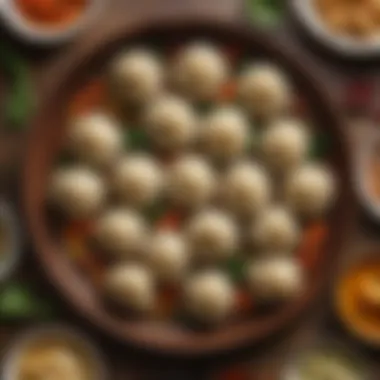
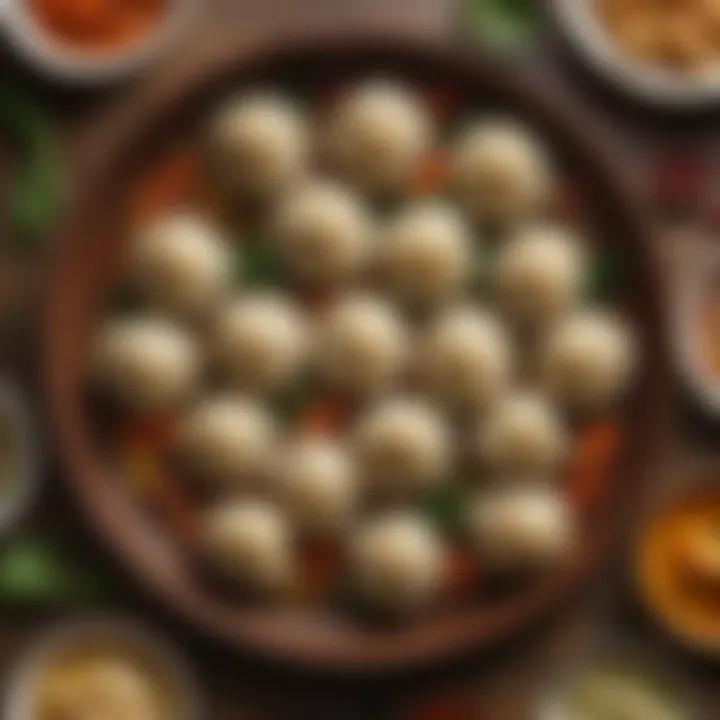
Intro
Dumplings have made their mark in the tapestry of global cuisine, uniting food lovers and cultures in shared experience. From the savory steamed buns of China to the delicate pierogi of Poland, this delicious dish is as varied as it is cherished. The history behind dumplings is rich, full of local traditions and stories; each variety reflects unique cultural narratives and cooking techniques.
Each bite tells a tale of ingredients coming together— and the often intricate ways they are stuffed, folded, and cooked. They can be found sizzling in street food stalls, elegantly plated in fine dining restaurants, or savored during family gatherings. In essence, dumplings encapsulate the heart of comfort food, transcending borders and diets alike.
The purpose of this exploration into dumplings goes beyond merely satisfying cravings; it becomes a journey into understanding cooking as a form of art and expression. In the upcoming sections, we’ll dive deep into the history, types, and techniques related to dumplings while highlighting notable recipes and modern adaptations. Whether you're a culinary novice, a home cook aiming for perfection, or simply a curious food lover, this guide strives to offer insight that enriches your culinary adventures.
Prelude to Dumplings
Dumplings sit at the crossroads of comfort food and culinary art, transcending geographical and cultural boundaries. They are more than just a dish; dumplings hold stories passed down through generations, representing tradition, innovation, and the heart of numerous cuisines. Delving into the world of dumplings reveals not only their diverse forms but also their role in uniting people during celebrations, family gatherings, and even at casual meals.
Defining Dumplings
In simple terms, dumplings can be described as pieces of dough filled with various ingredients or simply dough that is cooked alone. While this definition might seem straightforward, the variants are as vast as the cultures from which they come. Dumplings may be round, flat, or folded, and they can be stuffed with proteins like pork, chicken, fish, or vegetables and herbs. The wrapper could be made from different types of flour, giving it unique textures and flavors.
For a deeper understanding, consider the different cooking methods that bring these delights to life. Dumplings can be boiled, steamed, fried, or baked, each technique infusing them with distinct tastes and sensations. You might enjoy a steaming basket of dim sum on a Sunday morning or savor a golden-brown pierogi during a festive dinner. Each bite is a delightful narrative on its own, narrating tales of local ingredients and culinary traditions.
The Historical Context of Dumplings
The journey of dumplings through history is as rich as the fillings they contain. Historical records suggest that dumplings have existed for over 1,800 years, with origins tracing back to ancient China. However, dumplings are not confined to one geographical area. Cultures around the world have embraced the concept of filled dough, adapting it to their available resources and tastes.
- In Italy, ravioli emerged during the Renaissance, showcasing fresh ingredients and craft.
- The Polish pierogi date back to the 13th century, influenced by the combination of Eastern and Western European flavors.
- In the Americas, the empanada reflects the fusion of indigenous and colonial traditions.
As trade routes expanded, so did the flavors and techniques associated with dumplings. They evolved, incorporating regional nuances, making it evident that dumplings are a universal comfort food
"Dumplings are not just a meal; they are a testament to shared cultures and culinary histories across the globe."
Thus, dumplings serve as a delicious metaphor for history itself—each region brings its own unique spin, adding layers to the narrative of food. In this culinary exploration, the significance of dumplings becomes clear: they embody tradition while simultaneously embracing new methodologies. The adventure into dumpling territory is one worth embarking on for enthusiasts and culinary novices alike.
Varieties of Dumplings
Dumplings represent a delightful intersection of cultural heritage and culinary creativity across the globe. Exploring varieties of dumplings not only uncovers the rich tapestry of ingredients and techniques used in their preparation but also highlights the regional preferences and historical contexts that shape their existence. Dumplings serve as emblematic dishes that reflect local tastes and customs, promoting a sense of community during shared meals. Given their vast array of forms and flavors, delving into the different types enables enthusiasts to appreciate how these morsels transcend mere sustenance, becoming vital components of diverse culinary traditions.
Asian Dumplings
Asian dumplings, known for their intricate flavors and various textures, are a point of pride in many cultures across the continent. Each type offers a glimpse into the history and evolution of its respective cuisine, while also emphasizing the artistry involved in their making.
Chinese Jiaozi
When thinking of Chinese Jiaozi, the first aspect that springs to mind is their role in Chinese New Year celebrations, symbolizing prosperity. These dumplings are typically filled with ground meats and vegetables, wrapped in a thin dough, and can be boiled, steamed, or pan-fried to perfection. A key characteristic is their half-moon shape, which represents wealth—an essential aspect for many families celebrating the festival. The appeal of Jiaozi lies in their versatility; they can be made with nearly any filling which makes them popular among diverse eaters. However, creating the perfect wrap and ensuring a well-balanced filling can be a bit of a challenge, akin to walking a tightrope between flavors.
Gyoza from Japan
Shifting focus to Gyoza from Japan, these dumplings have captured hearts beyond their homeland. With a thinner skin than their Chinese counterparts and a distinct method of preparation, Gyoza are often pan-fried to achieve a crispy bottom while steaming the top. Their unique feature lies in their delicate folding style, resembling a crimped edge, which adds to their aesthetic appeal. Gyoza are widely enjoyed as comfort food and can be customized to suit various dietary preferences. However, the cooking technique might require some practice—getting the skillet temperature just right can be tricky.
Korean Mandu
Korean Mandu embodies yet another exciting variety within the realm of dumplings. Notably, these dumplings may be steamed, boiled, or fried, depending on personal preference. What sets Mandu apart is their unique incorporation of ingredients like tofu and glass noodles, which introduces a distinct texture. Typically served during celebrations and as street food, the versatility of Mandu makes them a fascinating addition to this culinary journey. The potential downside might be the complexity in the filling preparation, which could deter beginners.
European Dumplings
As we venture beyond Asia, European dumplings reflect a heartier approach to this culinary staple. These dumplings showcase local produce and cooking methods, turning simple ingredients into satisfying fare.
Pierogi from Poland
In Poland, you can't speak about dumplings without mentioning Pierogi. These delightful pockets are usually filled with potatoes, sauerkraut, or meats and can be boiled and then sautéed in butter for extra flavor. The key characteristic of Pierogi is their soft, pliable dough that can be formed into both half-moon and rectangular shapes. Their robust flavors make them a staple at family gatherings and festivals, where they symbolize abundance. However, making the dough can be somewhat temperamental, requiring a deft hand to ensure it isn't too thick.
Knödel from Germany
Moving on to Knödel from Germany, these dumplings somewhat differ in their composition compared to their Eastern European cousins. Typically made from bread, potatoes, or even flour, they serve to soak up rich sauces or gravies, often appearing alongside hearty meats or stews. Knödel's strength lies in their adaptability, making them a beloved comfort food choice. Nevertheless, their density can be quite filling, which some may find overwhelming in a large meal setting.
Ravioli from Italy
Last but not least, we explore Ravioli from Italy, a beloved representative of Italian cuisine. These pasta dumplings can be filled with a variety of ingredients, from ricotta and spinach to hearty meats, and are traditionally served with sauces that enhance their flavor. The hallmark of Ravioli is their handmade quality; they often feature delicate pasta squares dulled from light rolling. While Ravioli can be time-consuming to prepare from scratch, their rich flavors and comforting appeal make them well worth the effort.
Latin American Versions
Latin American dumplings offer a unique twist, strongly influenced by local flavors and culinary traditions. Each iteration tells a story, revealing the region’s history and communal dining practices.
Empanadas
Empanadas stand out as a staple of various Latin American cuisines. These are pastries filled with diverse ingredients including meats, cheeses, or vegetables, encased within a flaky dough. The crimped edges not only reinforce the structure but also result in a satisfying crunch. The beauty of Empanadas lies in their portability and versatility—they can be baked or fried, making them suitable for both casual and festive dining. However, balancing the filling and ensuring it doesn’t overflow during cooking can be a bit of a conundrum.
Arepas
Then we have Arepas, which are made from a simple corn dough, offering a gluten-free alternative that’s exceptionally popular in Venezuela and Colombia. These round discs can be sliced open and stuffed with a variety of fillings, from cheese to shredded meat. Their defining quality is the delightful crispiness achieved through grilling or frying, creating a contrasting texture to the soft interior. One drawback is that the dough must be prepared correctly to achieve that perfect consistency, or they may end up too dry and tough.
Sopes
Finally, Sopes present a unique Mexican twist on dumplings. They consist of small, thick tortillas topped with various ingredients such as beans, meat, and fresh vegetables. One intriguing aspect of Sopes is their built-in edge, which holds the toppings better than a standard tortilla. This not only enhances presentation but also aids in the enjoyment of flavors. However, the complexity of flavors can sometimes be overwhelming for those not used to them.
The variety in dumplings across different cultures is a testament to the culinary creativity and adaptability of communities worldwide.
Dumpling Ingredients and Preparation
The heart of any dumpling lies in its ingredients and the manner in which they're prepared. This section highlights the role of quality components and techniques, demonstrating how they weave the flavors, textures, and overall appeal of dumplings. From the flour used to the spices that dance in the fillings, each ingredient serves a purpose. Understanding these elements can elevate a simple dish into a flavorful masterpiece.
Common Ingredients Used
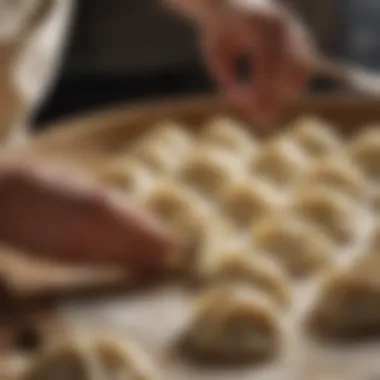

Flours and Wrappers
When it comes to dumpling wrappers, the choice of flour is paramount. The most common types are all-purpose wheat flour and rice flour, with each presenting its own characteristics. The key trait of wheat flour wrappers is their elasticity, which allows them to stretch without breaking. This quality is beneficial as it creates a perfect canvas for the filling inside.
Moreover, using different flours can yield various textures and flavors.
For example:
- Wheat flour provides a chewy, satisfying bite.
- Rice flour, on the other hand, offers a softer, more delicate option.
Both types have pros and cons. Wheat flour is versatile and widely available, but gluten intolerant people may need alternatives like rice or tapioca flour. Thus, the choice of wrapper flour directly influences the interpretation of a dumpling.
Filling Types
Dumplings can be filled with an array of ingredients, from wholesome vegetables to succulent meats. The key characteristic of filling types is their ability to carry diverse flavors. For instance, pork and chive fillings are popular in Chinese dumpling cuisine, whereas potato and cheese can be found in Polish pierogi.
This variety not only broadens the taste spectrum but also allows for catering to dietary preferences. Vegan options are made using tofu, mushrooms, or various legumes, which can be as flavorful as any meat-based filling. Moreover, this flexibility allows for seasonal adaptations, enabling one to use fresh produce based on what's available.
However, a unique filling can sometimes lead to challenges in balancing flavors; care should be taken to avoid overpowering the dumpling wrapper.
Seasoning and Spices
The role of seasoning and spices cannot be overstated in dumpling preparation. They can transform a simple filling into a culinary adventure. Key herbs like ginger, garlic, and scallions are often used in Chinese dumplings to impart freshness and depth. Similarly, in Italian ravioli, a hint of nutmeg can add a delicate warmth that elevates the dish to another level.
Seasoning is also about balance. Too much salt can ruin an otherwise perfect filling, whereas too little may leave it bland. This is why understanding the ingredients and their interactions is crucial for achieving harmony in flavor.
Their unique feature is the ability to adjust to personal or regional tastes; for example, some families might lean into spicy elements while others prefer milder undertones.
Techniques for Making Dumplings
Making dumplings is an art that requires specific skills. Each technique enhances the overall structure and ensures the filling remains intact, creating a satisfying bite. Here, we break down the meticulous steps involved in crafting dumplings.
Rolling and Shaping
The rolling and shaping of dumpling wrappers can be viewed as a form of expression. Proper technique ensures that they are evenly shaped and not too thick. Using a rolling pin to create dough of uniform thickness is significant for even cooking. A key characteristic of this step is precision; if the edges are thicker than the center, it can lead to uneven cooking.
A beneficial aspect to mastering this technique is the ability to create various styles, such as the crescent-shaped gyoza or the round Italian ravioli.
Additionally, there's an art to the way wrappers are folded. Each type has its unique method, and knowing these nuances can make or break a dumpling's aesthetic appeal.
Filling and Sealing
Filling and sealing dumplings is another crucial technique. The goal here is to achieve a perfect seal that holds the filling securely while preventing moisture from escaping during cooking. A key characteristic of this step is attention to detail; the corners need to be pinched tightly to avoid leakage.
A beneficial choice here is using a bit of water or egg to moisten the edges, which helps the wrapper adhere better. The unique feature of this technique lies in its ability to showcase creativity—there are countless ways to twist or pleat the wrapper, providing each dumpling with an individual touch. However, a common pitfall is overfilling. Too much filling can burst the dumpling during cooking.
Cooking Methods
Cooking methods for dumplings greatly impact their texture and flavor. Popular techniques include steaming, boiling, and pan-frying—each contributes differently.
The key characteristic of steaming, for instance, is how it retains moisture, making for plump and juicy dumplings. This method is beneficial for individuals seeking a healthier option since it doesn't require any oil.
In contrast, pan-frying introduces a crispy texture that can elevate the dumpling experience, offering a lovely contrast to the soft filler within. However, boiling, while easy, can sometimes dilute flavors. Each cooking method caters to different palates, and knowing when to apply one over the others can turn a simple dish into a remarkable one.
Understanding the ingredients and techniques provides a roadmap not just for cooking but for appreciating the rich world of dumplings.
Cultural Significance of Dumplings
Dumplings are more than just a delightful dish; they are a symbol of cultural heritage, community, and celebration. Throughout the ages, dumplings have played a vital role in various cuisines around the world, each with its own story and significance. As people gather around these delicious morsels, they not only partake in a meal but also in a shared experience that often transcends generations. The cultural significance of dumplings is essential for understanding their impact on different societies and traditions.
Dumplings in Festivities
New Year's Celebrations
Dumplings have a prominent place in New Year celebrations across many cultures. For instance, in Chinese tradition, families make jiaozi to celebrate the new lunar year. Typically, these dumplings resemble ancient Chinese gold ingots, symbolizing wealth and prosperity for the upcoming year. Preparing and eating them together is more than a culinary practice; it embodies the spirit of family unity and hope.
The collective act of making jiaozi becomes a ritual, fostering connections between family members as they pass down techniques from one generation to the next. This shared experience transforms what could be a mundane cooking task into an honored tradition. Thus, dumplings serve not only as a meal but also as vessels of familial ties and aspirations.
Seasonal Festivals
Apart from New Year, dumplings find their way into various seasonal festivals, acting as a joyful representation of the changing seasons. In many cultures, festivals centered around harvest time include dumplings made with fresh, seasonal ingredients. This aspect not only brings communities together to celebrate the bounty of nature but also nurtures an appreciation for local produce.
Whether it’s pierogi during Polish harvest festivals or mantou in autumn celebrations in China, the preparation of these dumplings signifies gratitude for the harvest, evoking a sense of community and togetherness. This is where dumplings become more than mere food; they are a celebration of life’s rhythms.
Symbolism of Dumplings
Prosperity and Togetherness
Dumplings symbolize prosperity and unity across various cultures. This dual significance emerges from both their form and the context in which they are shared. For example, the round shape of many dumplings signifies completeness and the promise of ample blessings. Often served during significant occasions, they remind people of the importance of gathering and sharing meals with loved ones.
Their role in fostering togetherness has made them a popular choice for gatherings and celebrations. As families and friends share dumplings, they strengthen the bonds that keep communities intertwined. The act of sharing also reflects cultural values, such as support, gratitude, and love.
Culinary Traditions
In many kitchens, dumplings are more than just a recipe; they represent a cultural canvas that reflects a community's history and values. Culinary traditions surrounding dumplings often involve unique recipes passed down through generations, showcasing the connection between past and present. This lens allows for a deeper appreciation of the art of cooking, as history and culture intermingle on the plates.
Traditional preparation techniques, family variations, and specific ingredients give dumplings their distinctive character within each culture. Despite the differences, the underlying principle remains the same—the connection to heritage and the celebration of cultural identity is enriched by sharing dumpling meals.
"Dumplings bridge gaps between cultures, telling stories that are whispered across generations."
Through both festivities and symbolism, dumplings carve out a significant space in the cultural tapestry of societies worldwide. Their ability to unite people in both celebration and culinary delight reveals their enduring allure.
Innovative Dumpling Creations
Innovative dumpling creations represent a fascinating intersection of culinary tradition and modern creativity. This section showcases how reinventing classic dumplings can captivate the taste buds of contemporary food lovers. In a diverse world of cuisines, innovation does not merely mean changing the look of dumplings; it’s about enhancing flavors and philosophical approaches to food. By experimenting with healthier ingredients or blending cultural techniques from around the globe, these unique dumplings can cater to a wider audience, allowing for a more inclusive dining experience. It's essential to recognize the balance between honoring tradition while welcoming change in dumpling-making.
Fusion Dumplings
Cross-Cultural Flavors
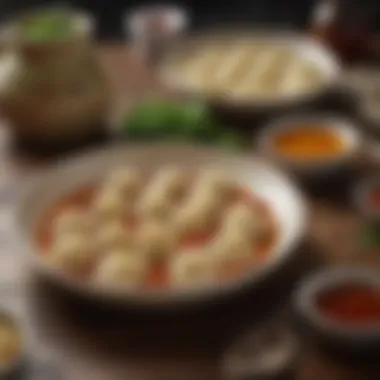
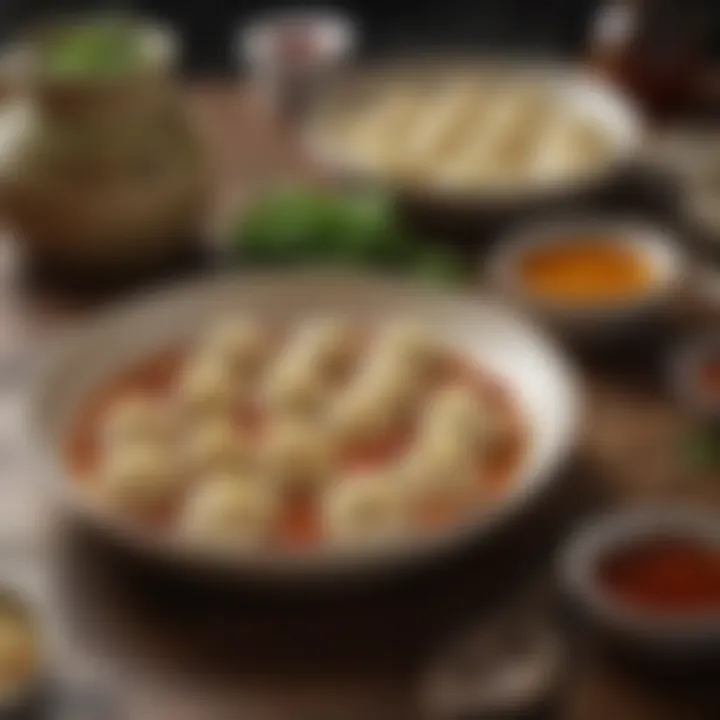
Cross-cultural flavors have emerged as a delightful trend, combining elements from various culinary landscapes into one package. The beauty of fusion dumplings lies in their ability to expand the palate by mixing ingredients and preparation styles from different cultures. A perfect example would be Korean BBQ-inspired dumplings, which intertwine spices and meat preparations from Korean barbeque into the traditional structure of Chinese dumplings. This dynamic merging provides a fresh take on a beloved dish that excites even the most discerning food enthusiasts. The advantage? They introduce novelty and encourage shared dining experiences across cultures, leading to greater appreciation and understanding of global cuisines.
Modern Interpretations
Modern interpretations of dumplings delve into new cooking methodologies and ingredient profiles that embrace what today’s health-conscious eaters desire. For instance, a popular method is employing sous-vide techniques to ensure precise cooking, preserving the texture and flavors while preventing drying out. Furthermore, chefs are playing with alternative fillings such as quinoa, lentils, or exotic mushrooms, reflecting a shift towards plant-based meals. This new approach not only appeals to vegans and vegetarians but also intrigues those seeking a twist on their favorite dishes. While some might bemoan straying too far from tradition, these modern interpretations invite dialogue about the future of cuisine, and how timeless dishes can evolve.
Health-Conscious Variants
As dietary preferences diversify, health-conscious variants of dumplings have gained popularity and importance in our culinary landscape. These adaptations ensure that while flavor remains intact, nutritional considerations also take precedence. This section delves into the implications of health-conscious decisions in dumpling recipes and why they're slowly becoming mainstream.
Gluten-Free Options
Gluten-free options for dumplings cater to a growing number of individuals sensitive to gluten or choosing to avoid it. Utilizing flours such as rice flour or chickpea flour, chefs can whip up dumplings that maintain the desired chewy consistency. Not only do they open up culinary doors for those with dietary restrictions, but they also provide an opportunity to rediscover the multiple textures that different flours can offer in dumpling fillings. The main drawback, however, is that gluten-free dough often requires more careful handling, as it can be less forgiving than traditional flour. Yet, the benefits of inclusivity and health make this effort worthwhile.
Plant-Based Alternatives
Plant-based alternatives highlight how dumplings can remain true to their essence while adapting to the needs of vegetarian and vegan eaters. By using mushrooms, lentils, and vegetables for fillings, creators can pack a punch of flavor without relying on animal products. These alternatives not only align with growing global trends toward sustainability but also intrigue meat-eaters willing to step outside the box. A downside can be the perception that vegan dumplings lack the richness or depth compared to traditional ones; however, with the right seasoning and cooking methods, they can rival their meat-filled counterparts in flavor.
"Innovation in the kitchen is not just about altering flavors; it's also about respect for what has come before, facilitating dialogue between the past and the present."
Dumpling Sauces and Accompaniments
Dumpling sauces and accompaniments are essential components in elevating the overall dining experience. They not only enhance the flavor profile of the dumplings but also bring in diverse textures, which keeps every bite interesting. Whether you prefer a spicy kick or a subtle tangy essence, the right sauce can transform a simple dish into a culinary delight.
Traditional Dipping Sauces
Soy Sauce Variations
The classic soy sauce holds an important place when considering sauces for dumplings. It serves as a common base, but variations abound, each adding its unique touch. For instance, light soy sauce is typically more salty and can complement steamed dumplings nicely, while dark soy sauce offers a richer, slightly sweeter flavor, making it suitable for fried dumplings.
Key Characteristics: These variations can include additions such as sesame oil or garlic, giving them a layered taste that enchants the palate.
Advantages: The adaptability of soy sauce means it can pair with almost any dumpling style, enhancing both flavor and moisture. This makes it a popular choice among cooks and diners alike.
Disadvantages: However, those watching their sodium intake might find certain soy sauce variations too salty. Thus, it’s crucial to choose accordingly for certain dietary preferences.
Chili Oil and Vinegar Mixes
Chili oil and vinegar mixes bring heat and acidity to the table, establishing themselves as captivating condiments for dumplings. This combination not only complements the taste of dumplings but also provides an invigorating zing.
Key Characteristics: Typically, chili oil features infused peppers, while adding vinegar creates a tangy finish that cuts through the richness of the dumpling filling.
Advantages: The beauty of these mixes lies in their customizable nature—adding more chili can suit heat lovers, while varying the vinegar type (rice, apple cider, or even balsamic) can change the flavor dynamics completely.
Disadvantages: On the flip side, some might find the heat overpowering or the combination too intense for delicate dumplings. A careful balance is essential to maximize enjoyment.
Contemporary Accompaniments
Herb and Spice Infusions
Herb and spice infusions are gaining traction as innovative accompaniments that can enhance the flavor profile of dumplings. These infusions might include freshly chopped cilantro, mint, or chives mixed with various oils or vinegar.
Key Characteristics: They offer freshness that contrasts beautifully against heavier fillings or richer sauces.
Advantages: This option is not only refreshing but can also add vibrancy to the meal, appealing especially to those who appreciate aromatic herbs. They can be tailored to individual tastes, making them versatile.
Disadvantages: However, not everyone's palate may align with strong herbal flavors, and thus, it can be a polarizing choice depending on the context of the meal.
Garnishes and Side Dishes
Accompanying a main dumpling dish with garnishes and side dishes is another way of enhancing the meal. These can range from pickled vegetables to salad blends, allowing for texture and flavor variety on the plate.
Key Characteristics: The addition of a crunch factor or contrasting flavors can elevate the experience considerably, creating a multi-layered meal.
Advantages: They offer an opportunity to include more nutrients on the plate, inviting diners to make a well-rounded meal. These variations could spark interesting combination ideas, enticing the adventurous eater.
Disadvantages: On the downside, if the side dishes or garnishes overpower the dumplings themselves, the essence of the main dish could get lost. Thus, a degree of understanding and balance is necessary.
Ultimately, whether opting for traditional or modern additions, the choice of sauces and accompaniments can significantly shape the dumpling dining experience, ensuring it is memorable, fulfilling, and delicious.
Cooking Methods for Dumplings
The way dumplings are cooked can make or break the dish. Each method brings out different flavors and textures, showcasing the versatility of these delightful pockets of goodness. Cooking methods involves a variety of techniques that align with the ingredients used, preferences of diners, and cultural traditions. Mastering these techniques not only enhances the taste but also retains the nutritional merits of the fillings. Let's explore a few common methods that bring dumplings to life.
Steaming Techniques
Bamboo Steaming
Bamboo steaming is a time-honored tradition that hails from various Asian cuisines, particularly Chinese. This method employs stackable bamboo baskets which allow the steam to circulate evenly. The key characteristic of bamboo steaming is its gentle cooking process. It preserves delicate flavors and keeps the dumplings moist while maintaining a slightly chewy texture. What's beneficial about this method is it requires no oil, making it a lighter option compared to frying.
One unique feature of bamboo steaming is its ability to infuse aroma from the herbs or vegetables placed in the water underneath. However, it can be less forgiving if not timed correctly, as over-steaming might lead to soggy dumplings—nobody enjoys a squishy bite!
Electric Steamers
Electric steamers have made cooking dumplings a breeze for many home cooks. This method is user-friendly and offers precise control over steaming times. Its key advantage lies in the consistent heat distribution that ensures even cooking of dumplings, whether you're making gyoza or jiaozi.
The unique feature of electric steamers is their ability to prepare large batches simultaneously, making them perfect for gatherings. On the downside, some might argue it lacks the traditional touch or flavor imparted by bamboo steamers, but for sheer convenience, electric steamers hold a spot in many kitchens today.
Boiling and Pan-Frying
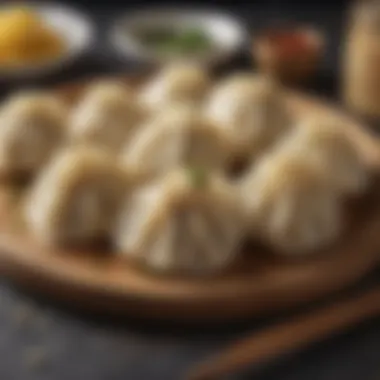
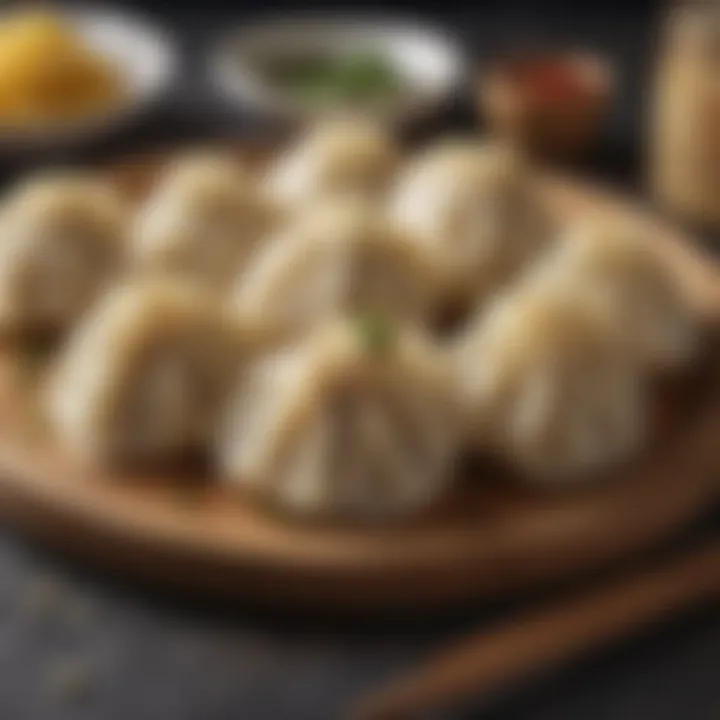
Water Boiling Methods
Boiling is arguably one of the simplest and most approachable methods for cooking dumplings. It involves submerging dumplings in salted water until they float, which indicates they’re ready to be drained. The primary characteristic of water boiling lies in its rapid cooking process, which helps maintain firm textures without compromising the filling's taste.
Boiling provides a truly versatile foundation for cooking different types of dumplings. A distinct feature of this method is the potential for creating a broth using the cooking water. The downside however is, that it tends to leave the dumplings a bit wet, which may not appeal to every palate.
Pan-Frying Principles
Pan-frying, on the other hand, introduces a lovely crispy texture that can elevate the experience of dining on dumplings. This method commonly features a two-step cooking process: first, the dumplings are lightly fried until golden, followed by adding a splash of water and covering until they steam through. The key characteristic here is the beautiful contrast between the crunchy base and the soft top.
Pan-frying also has a unique feature—achieving that crispy texture while still retaining moisture inside is like walking a tightrope, but when done right, it’s bliss. However, this method can be tricky as it requires attention to avoid burning and ensure even cooking.
Baking and Frying Dumplings
Oven Baking Techniques
Oven baking is less common for dumplings but can yield interesting results when executed thoughtfully. The method offers a different texture, providing a golden, crisped exterior that some may prefer over boiling or steaming. Its key characteristic is that it allows for an even, controlled cooking environment, which can free up stovetop space when making large batches.
One unique advantage of oven baking is the opportunity to experiment with different fillings, turning dumplings into pocket-like pastries. On the contrary, the drawback might be that the filling may dry out more quickly if not monitored.
Deep-Frying Tips
Deep-frying dumplings is a sure way to create indulgent fare that shines. The primary benefit of deep-frying is achieving that delightful crispy outer layer while keeping the insides tender and flavorful. The key characteristic here is the quick cooking time, preventing the filling from losing moisture.
The unique feature of deep-frying is the ability to create varied textures based on the batter used. However, it can be heavy on the palate and is not the healthiest option, making it a special treat rather than a regular go-to method.
Cooking dumplings can be a delightful journey. Each method provides a unique outcome, enhancing the overall experience and pleasure of these goodies. Choosing the right technique can elevate not only flavor but also the joy of sharing these culinary wonders with loved ones.
Storing and Reheating Dumplings
Dumplings, adored across numerous cultures, offer an immediate sense of comfort and satisfaction. However, their longevity outside the pot invites an important conversation on storing and reheating. Understanding how to properly store dumplings can greatly enhance their flavor and texture for a future meal. This section delves into smart strategies to keep your dumplings fresh as well as effective reheating methods to revitalize their original taste when it's time to dig in again.
Freezing Dumplings
Freezing is an excellent way to preserve dumplings, ensuring that they retain their flavor and texture even months down the line.
Best Practices
When it comes to freezing dumplings, the first step is to use a flash-freezing technique. Before placing them in a freezer bag, arrange the dumplings in a single layer on a parchment paper-lined tray. Pop them in the freezer until they are hard—as a rock! This method not only helps prevent them from sticking together but also maintains their shape, which is essential when you're ready to cook them later.
Why is this method so popular? By keeping dumplings separate and freezing them quickly, you can ensure that they maintain their non-sticky quality. Another key characteristic of this approach is that it allows you to take out just the number you need for a meal, rather than thawing everything at once.
Pros: Maintains texture and shape; easy to use; reduces mess during cooking.
Cons: Requires some planning and initial freeze time.
Storage Tips
After flash freezing, which is the best way to start, you can store your dumplings in freezer bags. Squeeze the air out to prevent freezer burn. A great tip is to label the bags with the type of dumpling and the date of freezing. This not only keeps your freezer organized but also helps you track freshness. It is a beneficial choice because you can easily keep your selections distinguishable.
The unique feature of this method lies in its simplicity and efficiency. You can freeze your dumplings for up to three months without worry.
Pros: Organized storage; prevents freezer burn; easy to manage portions.
Cons: Can take up freezer space.
Reheating Methods
Reheating dumplings correctly is just as crucial as how they were frozen. It is essential to preserve their delightful flavors and textures.
Steaming for Freshness
Steaming is a top-notch method for reheating dumplings. This technique helps to revitalize them while preserving moisture. The beauty of steaming is that it recreates that fresh-out-of-the-steamer taste. Place your frozen dumplings in a steamer basket lined with cabbage or parchment paper and steam for about 10-15 minutes. This method is not only effective but ensures that they are heated evenly.
Why is this method favored? Steaming creates a soft, delicate texture not achievable through other methods. Furthermore, it prevents the dumplings from drying out, making them feel like they were just made.
Pros: Preserves moisture; enhances flavor.
Cons: Requires specific tools like a steamer.
Microwave Techniques
Microwaving is the quickest way to reheat dumplings. Place your dumplings in a bowl with a splash of water to keep them from going dry. Cover with a damp paper towel and microwave for about 1-2 minutes, checking occasionally. While not traditional, this method is lauded for convenience, particularly on busy days.
The unique feature of this approach is that it’s fast and accessible for those who might not have a steamer. However, it can sometimes lead to rubbery textures if overheated.
Pros: Convenience and speed; minimal clean-up.
Cons: May dry out dumplings if not done carefully.
Always consider the method that works best for your schedule and resources when reheating.
Ultimately, understanding how to store and reheat dumplings optimally enhances their enjoyment when it comes time to savor these ever-popular bites.
The End
Dumplings hold a unique and cherished place in global cuisine. The various types of dumplings, ranging from Chinese jiaozi to Polish pierogi, are not just satisfying bites to eat; they bring together people and cultures, creating bonds over shared meals. These little pockets of goodness serve as a reminder that food is much more than sustenance; it’s a connecting force that tells stories of tradition, innovation, and love.
The Enduring Allure of Dumplings
There’s something magical about dumplings. Perhaps it's the way they embody comfort and familiarity. When you bite into one, it often invokes memories of home cooking, family gatherings, or even late-night dumpling runs after a long day. The ability to pack so much flavor and history into a neat little package is what makes dumplings such a beloved dish worldwide.
- Versatility: Dumplings can wear many hats—appetizer, main course, dessert. They can be filled with savory ingredients or sweet delights, appealing to a wide range of palates.
- Cultural Significance: Every culture has its take on dumplings, showcasing local ingredients and culinary methods. This richness adds layers of depth to understanding the culinary practices of different societies.
- Shared Experience: The process of making dumplings is often a communal activity, encouraging togetherness and the sharing of traditions across generations.
"Dumplings are universal, transcending borders and bringing people together, one bite at a time."
As we navigate various culinary landscapes, the exploration of dumplings leaves us not only satiated but enlightened. Embracing the art of dumpling-making opens avenues for creativity and adaptability in the kitchen, allowing cooks to infuse their personal touch into each bite. Understanding and celebrating the humble dumpling could well be the recipe for making connections—one delicious meal at a time.







